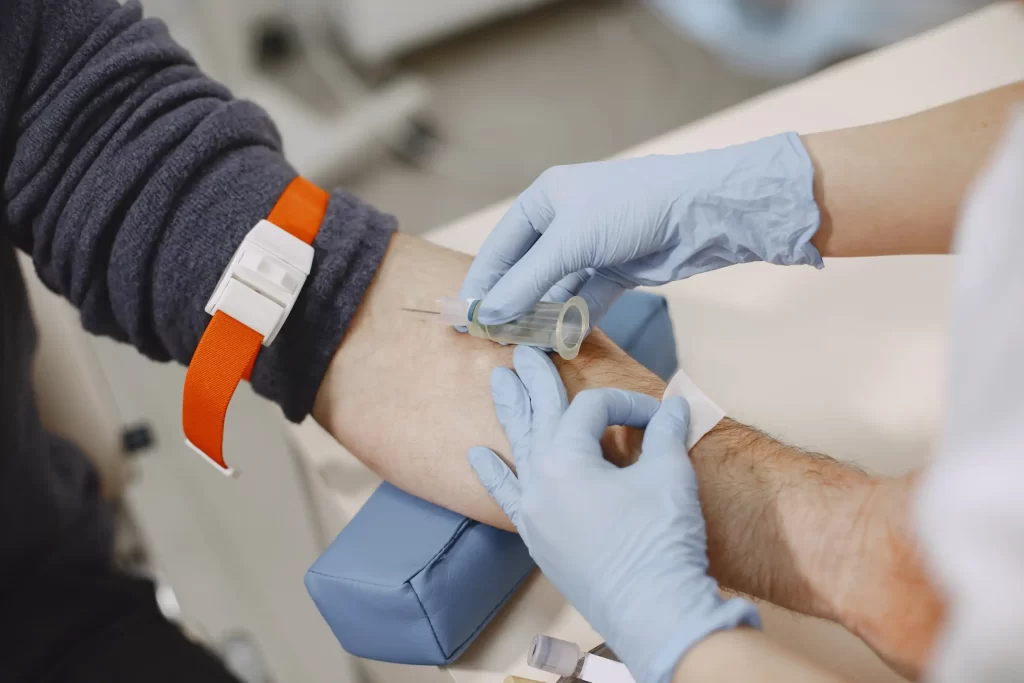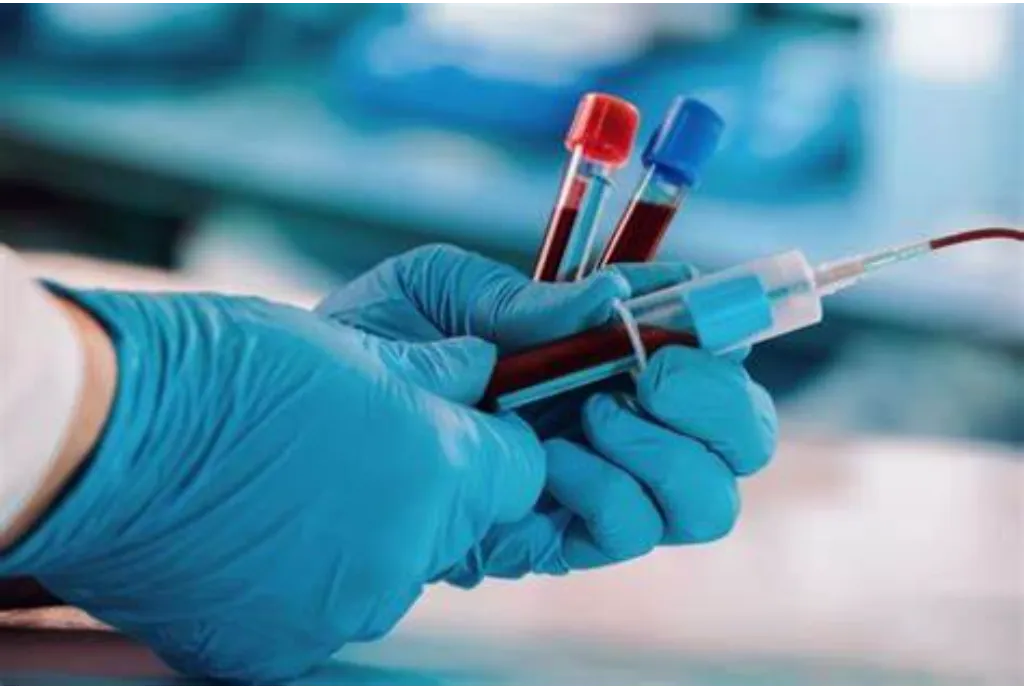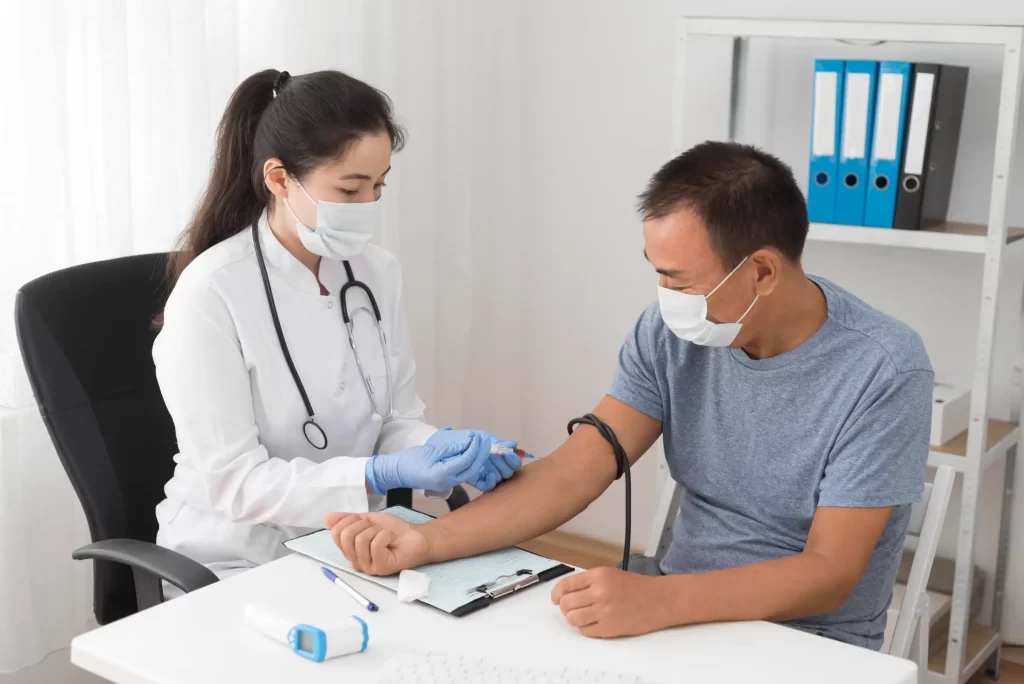If you are interested in the medical field but don’t have a degree, becoming a phlebotomist can be a great place to start. A phlebotomist is a healthcare professional who is responsible for drawing blood from patients and preparing it for lab testing.
In this blog post, we will provide you with a step-by-step guide on how to become a phlebotomist. We’ll cover everything from the education and training required to the job outlook and salary expectations. You’ll also learn about the duties of a phlebotomist and where they typically work.
Lastly, we’ll discuss the future of phlebotomy and answer some common questions people have about this career path. So, if you’re ready to take your first step towards becoming a phlebotomist, keep reading!
What is a Phlebotomist?
A phlebotomist is a healthcare professional specializing in drawing blood samples for medical tests and donations. They play a crucial role in ensuring accurate and safe collection while providing comfort to patients. With attention to detail and adherence to safety protocols, this rewarding career offers employment opportunities in clinical and non-clinical settings.
Overview of Phlebotomy
As mentioned earlier, phlebotomy is a medical procedure that involves drawing blood for diagnostic and therapeutic purposes, making it an integral part of the healthcare system. Phlebotomists play a vital role in ensuring that blood samples are collected accurately and safely. They use proper techniques, equipment, and maintain sterile conditions throughout the process.
In addition to collecting blood samples, phlebotomists also handle the labeling and processing of collected samples to ensure accurate diagnosis and treatment. To be successful in this profession, phlebotomists must know medical terminology and anatomy as they support accurate diagnosis and treatment.

In some cases, phlebotomists may also be responsible for explaining procedures to patients or calming anxious patients before taking their blood. Overall, phlebotomy is an essential aspect of healthcare that requires skilled professionals who are committed to providing safe and accurate services.
How to Become a Phlebotomist?
There are certain steps and procedures one must follow to become a phlebotomist.
Step 1: Graduate From High School or Earn a GED
To become a phlebotomist, obtaining a high school diploma or GED is typically required. It is recommended to take courses in biology, chemistry, and anatomy to prepare for the training ahead. Some programs may also have minimum GPA requirements for admission.
If you did not complete high school, various programs and testing centers offer GEDs so that you can meet this prerequisite. After obtaining your diploma or GED, research accredited phlebotomy training programs available in your area. Accredited training programs ensure that you receive quality education and valuable hands-on experience.
Step 2: Apply to an Accredited Phlebotomy Program
Choosing an accredited program that fits your budget and schedule is crucial when applying to become a phlebotomist. Accredited programs guarantee quality education and training, which can increase your chances of finding employment in the field.
Once you’ve selected a program, ensure that you meet all eligibility criteria and submit all necessary documents for enrollment. Upon acceptance, you’ll attend classes, complete coursework, and undergo clinical training to gain hands-on experience in the medical field. This will prepare you for a fulfilling career as a phlebotomist.
Step 3: Complete a Phlebotomy Program
The duration of these programs can range from 3-6 months and cover essential topics such as anatomy and medical terminology. Hands-on training is an integral part of the program where students learn blood collection techniques and how to handle specimens.
After completion of the program, some institutions may offer a certification exam to become a certified phlebotomy technician (CPT). It’s important to research and compare different programs available to find one that accommodates your schedule and aligns with your career goals.
Step 4: Earn a Certificate
Becoming a phlebotomist requires earning a certificate, which can be obtained by completing a phlebotomy certificate program. These programs typically last between 4-6 months and can be completed online or in person. The curriculum includes courses on venipuncture, anatomy, medical terminology, and other related topics.
Some programs even offer clinical practicums to provide students with hands-on experience. Once you have earned your certificate, you will be ready to take national certification exams such as the NCPT. This will allow you to demonstrate your knowledge and skills in phlebotomy and help you secure employment in the field.
Step 5: Take the Certification Exam
Once you have completed a phlebotomy program, taking the certification exam is the last step to becoming a certified phlebotomist. This exam guarantees that you have the required skills and knowledge to meet industry standards. It is offered by organizations like NHA, ASCP, and AMT and covers topics such as safety, infection control, and blood collection techniques. The exam fees may vary depending on the organization and location. Passing this certification exam is an essential milestone in your journey toward becoming a professional phlebotomist.
To prepare for the certification exam, it is advisable to take practice exams and review study materials provided by the certifying organizations. These resources can help you become familiar with the types of questions you will encounter on the actual exam and identify areas where you may need additional study or practice. Additionally, continuing education courses can help keep your knowledge up-to-date and ensure that you maintain your certification over time.
Becoming a certified phlebotomist not only validates your skills but also increases your employability in this rapidly growing field. It demonstrates your commitment to professionalism and patient safety while improving job opportunities and career advancement potential.
How Long Does It Take to Become a Phlebotomist?
To become a certified phlebotomist, it is essential to complete a phlebotomy program of at least 120 credits. This program may last three to six months and cover topics such as anatomy and physiology, laboratory techniques, and medical terminology.
A phlebotomy certification exam may also be required before applying for certification. This exam tests knowledge of medical terminology and laboratory techniques necessary to draw blood samples safely. It can take from as little as 8 weeks to less than a year to become certified, with most programs taking 4-8 months to complete. Some phlebotomy certification programs may require completing a clinical internship or hospital certification program.
What Does Phlebotomist Training Look Like?
Becoming a phlebotomist typically entails classroom instruction and laboratory experience, covering topics such as anatomy, medical terminology and physiology. High school or GED diploma holders may qualify for on-the-job training but must be certified and take continuing education courses to adhere to state regulations.
A certificate from a phlebotomy program is often necessary to enter the occupation. Professional certification is preferred by many employers, who view it as an indicator of phlebotomy training and experience.
Tuition and fees for a phlebotomy program vary based on the institution, with certificate programs costing up to $5,000 per year and associate degree programs costing between $7,000 and $16,000 per year.
Where Do Phlebotomists Work?
Phlebotomists have a range of work settings, including hospitals, clinics, laboratories, blood banks, research facilities, and public health organizations. They may also provide services in home healthcare or mobile phlebotomy units. Let’s take a look at each of the work settings in detail.
Clinical Settings for Phlebotomists
Phlebotomists play a crucial role in various clinical settings. Hospitals rely on them to collect blood samples from patients for diagnosis and treatment. Clinics and medical offices depend on phlebotomists for blood collection during tests and screenings. Laboratories hire phlebotomists to handle the processing and analysis of collected samples.

Public health departments may employ phlebotomists for blood-related research or surveillance. These professionals often collaborate with other healthcare providers to ensure accurate results. The demand for phlebotomists in clinical settings is high due to their essential contributions.
Non-Clinical Settings for Phlebotomists
Phlebotomists can work in a variety of non-clinical settings, expanding their roles beyond traditional healthcare facilities. Blood banks often employ phlebotomists to collect blood donations from voluntary donors, contributing to the ongoing supply of life-saving blood products.
Research facilities may require the expertise of phlebotomists to obtain blood samples for scientific studies, aiding advancements in medical knowledge. Additionally, pharmaceutical companies may hire phlebotomists for clinical trials, ensuring accurate and efficient blood sample collection. Public health organizations also rely on phlebotomists to provide community-based services and contribute to public health initiatives.
These non-clinical settings offer unique opportunities for phlebotomists to support public health and research endeavors.
Phlebotomist Salary and Job Outlook
Phlebotomists earn competitive salaries in the healthcare field. The demand for phlebotomists is expected to grow due to increased healthcare needs. Phlebotomists have diverse employment opportunities in various medical settings.
Professional certification can enhance job prospects and earning potential. The Bureau of Labor Statistics projects a positive job outlook for phlebotomists.
Average Salary for Phlebotomists
Phlebotomists earn a median annual salary of $39,110, with variations based on location and experience. Certification can lead to higher salaries, especially in state and local government positions. Competitive salaries can also be found in public health laboratories.
Factors such as tuition, externships, accreditation, and proof of experience contribute to career outlook in the field. The number of factors affecting salary and job prospects can vary by state, such as licensing requirements and registration with the National Healthcareer Association.
What factors influence how much phlebotomists make? Here are they:
1. Location: Phlebotomist salaries can vary significantly from one region to another. In some areas with a higher cost of living, phlebotomists may earn more than those in regions with a lower cost of living.
2. Experience: Experienced phlebotomists often earn higher salaries than entry-level phlebotomists. As they gain more experience and expertise, they become more valuable to employers.
3. Certification: Holding a phlebotomy certification can sometimes lead to higher pay as it demonstrates competency and dedication to the field. Certifications from organizations like the American Society for Clinical Pathology (ASCP) or the National Healthcareer Association (NHA) can be beneficial.
4. Type of Employer: The type of employer can impact salary. Phlebotomists working in hospitals, diagnostic laboratories, or larger healthcare facilities may have access to higher pay and benefits compared to those working in smaller clinics or blood donation centers.
5. Shift and Hours: Some phlebotomists may earn more if they work evening, night, or weekend shifts or if they work overtime hours.
6. Additional Skills: Phlebotomists with additional skills or responsibilities, such as handling specialized equipment or performing more advanced tasks, may command higher salaries.
Job Outlook for Phlebotomists
The healthcare industry’s growth has created a surge in demand for phlebotomists. Hospitals, clinics, and diagnostic laboratories are expected to offer increased employment opportunities in this field. Possessing specialized skills, such as pediatric or geriatric phlebotomy, can further improve job prospects. The aging population and advancements in medical technology also contribute to a positive career outlook.
Phlebotomy is an excellent way to quickly enter the healthcare sector and obtain fast employment opportunities. It requires less training than other healthcare professions, and with experience and additional certification courses, there is room for career advancement.
Duties of a Phlebotomist
The duties of a phlebotomist involve a series of specific tasks and responsibilities related to blood collection and patient care. Here is a detailed breakdown of their duties:
1. Patient Interaction and Communication:
– Greet and establish rapport with patients, creating a comfortable and reassuring environment.
– Explain the blood collection procedure to patients, addressing any concerns or questions they may have.
– Verify patient identities by checking their identification and asking for their name and date of birth to ensure accurate labeling of samples.
2. Preparation and Equipment Setup:
– Assemble and organize all the necessary equipment required for blood collection, including:
– Needles of various sizes for different types of draws (e.g., venipuncture, fingerstick).
– Collection tubes with appropriate additives for specific tests.
– Tourniquets to help locate and access veins.
– Alcohol swabs or other antiseptics for cleaning the puncture site.
– Gloves to maintain a sterile and safe environment.
– Ensure the cleanliness, sterility, and functionality of all equipment and work areas.
3. Venipuncture (Blood Collection):
– Assess and select suitable veins for blood collection, considering factors like vein size, location, and accessibility.
– Apply a tourniquet above the intended puncture site to engorge the vein and make it easier to access.
– Cleanse the puncture site with an antiseptic to prevent infection.
– Insert a sterile needle into the vein, controlling the angle and depth based on the vein’s characteristics.
– Collect the required amount of blood into the appropriate collection tubes, ensuring that the tubes are properly labeled and match the patient’s information.
– Safely remove the needle, release the tourniquet, and apply pressure and a bandage to the puncture site to stop bleeding and promote healing.
4. Labeling and Documentation:
– Accurately label all blood collection tubes with patient information, including name, date of birth, medical record number, and the date and time of collection.
– Document the collection procedure, including any difficulties encountered or complications in the patient’s medical record or laboratory requisition forms.
5. Safety and Infection Control:
– Strictly adhere to safety protocols to minimize the risk of needlestick injuries and the transmission of infections.
– Dispose of used needles and other sharps in designated sharps containers.
– Maintain a clean, organized, and sterile work environment to prevent contamination.
6. Quality Assurance:
– Ensure the integrity and proper handling of collected blood samples to maintain sample quality.
– Verify that collected samples are correctly matched with patient information to prevent errors.
7. Compassion and Patient Comfort:
– Provide emotional support and reassurance to anxious or apprehensive patients.
– Minimize pain and discomfort during the blood collection process through gentle and skilled techniques.
8. Equipment Maintenance:
– Perform routine maintenance on phlebotomy equipment, such as cleaning, calibration, and equipment checks.
– Report any malfunctioning or damaged equipment to the appropriate authorities for repair or replacement.

9. Continuing Education:
– Stay informed about the latest phlebotomy techniques, safety guidelines, and advancements in the field through ongoing education and training.
Overall, phlebotomists are an integral part of the healthcare system, playing a vital role in ensuring that patients receive safe and effective treatment. Their dedication to patient care is admirable and helps make a significant difference in people’s lives.
Future of Phlebotomy
Advancements in phlebotomy technology are revolutionizing the field, enhancing efficiency and accuracy. Automated blood collection devices are increasingly prevalent, streamlining the process. Point-of-care testing is an emerging trend that opens up new opportunities for phlebotomists. In addition, phlebotomy technicians may take on expanded roles, such as administering vaccinations. Staying updated with industry changes and pursuing continuous professional development are essential for future success.
New technologies such as vein finders and blood collection devices enhance the accuracy and efficiency of phlebotomy procedures. Electronic health records streamline the documentation and tracking of blood samples, ensuring better patient care. Automation reduces the risk of errors and improves the overall efficiency of blood collection. Furthermore, point-of-care testing devices allow for quicker analysis and diagnosis at the bedside. Phlebotomists who are trained in utilizing advanced technology have a competitive edge in the field.
Conclusion
In conclusion, becoming a phlebotomist requires a step-by-step process that includes completing high school, applying to an accredited program, completing the program, earning a certificate, and passing the certification exam. Phlebotomists can work in various clinical and non-clinical settings, and the salary and job outlook for this profession are promising.
The duties of a phlebotomist include drawing blood, ensuring patient care and safety, and handling and transporting blood samples. The future of phlebotomy is marked by advancements in technology and emerging trends in the field. Overall, becoming a phlebotomist is worth it for those interested in a rewarding healthcare career.
So, if you have a passion for helping others and enjoy working in a fast-paced environment, becoming a phlebotomist might be the right path for you.
FAQs
What are the merging trends in phlebotomy?
Phlebotomy is adapting to meet the changing healthcare landscape. Mobile phlebotomy services offer convenience for patients who can’t visit healthcare facilities. Advancements in genetic testing may require specialized training for phlebotomists. Technicians trained in pediatrics and geriatrics cater to specific patient populations.
The integration of telehealth and remote monitoring could impact phlebotomy practices in the future. Emerging trends in phlebotomy are shaping the way this field evolves to provide efficient and patient-centered care.
What do phlebotomists do?
Phlebotomists are trained medical professionals who draw blood from patients for lab tests or blood donations. They are responsible for collecting and properly storing samples. Phlebotomy is a growing field with increasing demand for trained professionals. The future of phlebotomy includes advancements in technology, such as improved equipment for safer and more efficient blood draws.
What is the work environment like for phlebotomists?
Phlebotomists find employment in various settings, such as hospitals, clinics, labs, and blood donation centers. Their work environment often involves standing for long periods, handling hazardous materials, and managing the risk of infectious diseases.
How much do phlebotomists earn?
Phlebotomists have the opportunity to earn a competitive salary with room for advancement. The average pay for a phlebotomist typically ranges from $35,000-$40,000 per year, although this can vary depending on location and employer. Experienced phlebotomists have the potential to earn higher salaries and may also receive additional benefits and bonuses.
With a job growth rate of 25% from 2016-2026, phlebotomy offers ample opportunities in the medical field. Further education and certification can lead to higher pay and greater job prospects in phlebotomy.
Is it worth it to become a Phlebotomist?
Considering the rewards and growth opportunities, becoming a Phlebotomist can be a worthwhile career choice. With an increasing demand for Phlebotomists and competitive salaries, this field offers promising prospects. However, your decision should ultimately be based on your interests and career goals.
What’s the difference between a Phlebotomist and a Phlebotomy Technician?
The terms “Phlebotomist” and “Phlebotomy Technician” are often used interchangeably, and the main difference is in the terminology. Both roles involve drawing blood from patients, but some employers may prefer to use the title “Phlebotomy Technician” to emphasize that the individual has undergone formal training and certification in phlebotomy procedures. In practice, the duties and responsibilities of Phlebotomists and Phlebotomy Technicians can be quite similar, and the distinction may vary by healthcare facility or organization.
Is it hard to get a job as a Phlebotomist?
The duties of a phlebotomist or a phlebotomy technician can vary depending on their state of practice and employer. However, both roles require specialized training and certification to ensure that they possess the necessary skills and knowledge to perform their duties effectively.
Phlebotomists typically work in hospitals, clinics, or blood donation centers, while phlebotomy technicians may also work in research laboratories or other medical facilities. Regardless of the setting, both roles play a critical role in healthcare by ensuring that accurate laboratory test results are obtained for proper diagnosis and treatment of patients.
What is the lowest salary for a phlebotomist?
The lowest salary for a phlebotomist can vary depending on factors such as location, experience, and education. However, on average, the lowest salary for a phlebotomist is typically around $25,000 to $30,000 per year. It is important to note that this figure is an estimate and actual salaries may vary. Additionally, salaries for phlebotomists can increase with additional certifications or specialized training.
Why is it called phlebotomist?
The term “phlebotomist” is derived from the Greek words “phlebo” meaning “vein” and “tomia” meaning “cutting.” In medical terminology, a phlebotomist is a healthcare professional who specializes in drawing blood from patients for various purposes, such as diagnostic testing or blood donation. The name reflects their primary role of accessing veins to obtain blood samples. Phlebotomists are trained in proper techniques for venipuncture (the process of puncturing a vein) and are responsible for ensuring the safety and comfort of patients during this procedure.

Leave a Reply